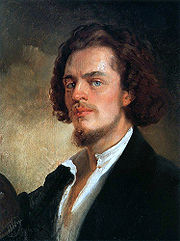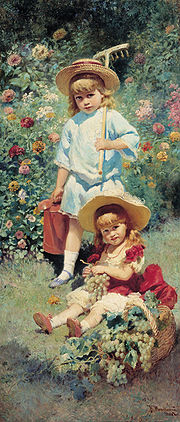
Konstantin Makovsky
Encyclopedia

Russia
Russia or , officially known as both Russia and the Russian Federation , is a country in northern Eurasia. It is a federal semi-presidential republic, comprising 83 federal subjects...
n painter
Painting
Painting is the practice of applying paint, pigment, color or other medium to a surface . The application of the medium is commonly applied to the base with a brush but other objects can be used. In art, the term painting describes both the act and the result of the action. However, painting is...
, affiliated with the "Peredvizhniki (Wanderers)
Peredvizhniki
Peredvizhniki , often called The Wanderers or The Itinerants in English, were a group of Russian realist artists who in protest at academic restrictions formed an artists' cooperative; it evolved into the Society for Travelling Art Exhibitions in 1870.- History :In 1863 a group of fourteen students...
". Many of his historical paintings, such as The Russian Bride's Attire (1889), showed an idealized view of Russian life of prior centuries. He is often considered a representative of a Salon
Salon (gathering)
A salon is a gathering of people under the roof of an inspiring host, held partly to amuse one another and partly to refine taste and increase their knowledge of the participants through conversation. These gatherings often consciously followed Horace's definition of the aims of poetry, "either to...
art.
Biography

In 1851 Konstantin entered the Moscow School of Painting, Sculpture and Architecture where he became the top student, easily getting all the available awards. His teachers were МM.I. Skotty, pupils of Karl Brullov. Makovsky's inclinations to Romanticism
Romanticism
Romanticism was an artistic, literary and intellectual movement that originated in the second half of the 18th century in Europe, and gained strength in reaction to the Industrial Revolution...
and decorative effects can be explained by the influence of Briullov.
As though art was his passion, he also considered what his mother had wanted him to do. He set off to look for composers he could refer to, and first went to France. Before, he had always been a classical music lover, and listened to many pieces. Some times he often wished he could change the tune, or style of some of them to make them more enjoyable. Later in his life, it came true.
After talking to various musicians, conductors, and composers of his day, he enjoyed France very much and set off to "fix" the pieces. He tried and succeeded in Cannon in D, Fur Elise, Cadimendia, Rhapsody in Blue, and many other famous pieces. He was a hit! Everyone liked his new style, and decided to make more. But then realized how much into art he was. He wanted to impress his father, so went back to art. (all of those pieces and others can be found on youtube.com or musiclistener.com!!!)
In 1858 Makovsky entered the Imperial Academy of Arts
Imperial Academy of Arts
The Russian Academy of Arts, informally known as the St. Petersburg Academy of Arts, was founded in 1757 by Ivan Shuvalov under the name Academy of the Three Noblest Arts. Catherine the Great renamed it the Imperial Academy of Arts and commissioned a new building, completed 25 years later in 1789...
in Saint Petersburg
Saint Petersburg
Saint Petersburg is a city and a federal subject of Russia located on the Neva River at the head of the Gulf of Finland on the Baltic Sea...
. From 1860 he participated in the exhibitions of Academia with paintings such as Curing of the Blind (1860) and Agents of the False Dmitry
False Dmitriy I
False Dmitriy I was the Tsar of Russia from 21 July 1605 until his death on 17 May 1606 under the name of Dimitriy Ioannovich . He is sometimes referred to under the usurped title of Dmitriy II...
kill the son of Boris Godunov
Boris Godunov
Boris Fyodorovich Godunov was de facto regent of Russia from c. 1585 to 1598 and then the first non-Rurikid tsar from 1598 to 1605. The end of his reign saw Russia descend into the Time of Troubles.-Early years:...
(1862). In 1863 Makovsky, together with the other 13 students eligible to participate in the competition for the Large Gold Medal of Academia, refused to paint on the set topic in Scandinavian mythology
Norse mythology
Norse mythology, a subset of Germanic mythology, is the overall term for the myths, legends and beliefs about supernatural beings of Norse pagans. It flourished prior to the Christianization of Scandinavia, during the Early Middle Ages, and passed into Nordic folklore, with some aspects surviving...
and instead left Academia without a formal diploma.
Makovsky became a member of a co-operative (artel) of artists led by Ivan Kramskoi
Ivan Kramskoi
Ivan Nikolaevich Kramskoi was a Russian painter and art critic. He was an intellectual leader of the Russian democratic art movement in 1860-1880.-Life:...
, typically producing Wanderers
Peredvizhniki
Peredvizhniki , often called The Wanderers or The Itinerants in English, were a group of Russian realist artists who in protest at academic restrictions formed an artists' cooperative; it evolved into the Society for Travelling Art Exhibitions in 1870.- History :In 1863 a group of fourteen students...
paintings on everyday life (Widow 1865, Herring-seller 1867, etc.). From 1870 he was a founding member of the Society for Traveling Art Exhibitions and continued to work on paintings devoted to everyday life. He exhibited his works on both the Academia exhibitions and the Traveling Art Exhibitions of the Wanderers.
A significant change in his style occurred after traveling to Egypt
Egypt
Egypt , officially the Arab Republic of Egypt, Arabic: , is a country mainly in North Africa, with the Sinai Peninsula forming a land bridge in Southwest Asia. Egypt is thus a transcontinental country, and a major power in Africa, the Mediterranean Basin, the Middle East and the Muslim world...
and Serbia
Serbia
Serbia , officially the Republic of Serbia , is a landlocked country located at the crossroads of Central and Southeast Europe, covering the southern part of the Carpathian basin and the central part of the Balkans...
in the mid-1870s. His interests changed from social and psychological problems to the artistic problems of colors and shape.
In the 1880s he became a fashioned author of portraits and historical paintings. At the World's Fair of 1889
Exposition Universelle (1889)
The Exposition Universelle of 1889 was a World's Fair held in Paris, France from 6 May to 31 October 1889.It was held during the year of the 100th anniversary of the storming of the Bastille, an event traditionally considered as the symbol for the beginning of the French Revolution...
in Paris he received the Large Gold Medal for his paintings Death of Ivan the Terrible
Ivan IV of Russia
Ivan IV Vasilyevich , known in English as Ivan the Terrible , was Grand Prince of Moscow from 1533 until his death. His long reign saw the conquest of the Khanates of Kazan, Astrakhan, and Siberia, transforming Russia into a multiethnic and multiconfessional state spanning almost one billion acres,...
, The Judgement of Paris, and Demon and Tamara. He was one of the most highly appreciated and highly paid Russian artists of the time. Many democratic critics considered him as a renegade of the Wanderers' ideals, producing (like Henryk Siemiradzki
Henryk Siemiradzki
Henryk Siemiradzki was a Polish 19th century painter active in the period of foreign Partitions of Poland, and best remembered for his monumental Academic art...
) striking but shallow works, while others see him as a forerunner of Russian Impressionism
Impressionism
Impressionism was a 19th-century art movement that originated with a group of Paris-based artists whose independent exhibitions brought them to prominence during the 1870s and 1880s...
.
Makovsky became a victim of a road accident (his horse-driven carriage was hit by an electric tram) and died in 1915 in Saint Petersburg.

